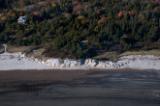Morse Mountain and Seawall Beach to Small Point by Beginning with Habitat
This area extends west from Popham Beach through Small Point and encompasses several ecologically important features, including Meetinghouse Pond, Parker Head Swamp, Seawall Beach, Sprague River, and Cape Small.
Lying between the Morse River to the east and the Sprague River to the west, the Morse Mountain and Seawall Beach area supports several uncommon and high-quality habitats, including most of those listed above for the Popham Beach area. In addition, the interior supports a small but intact maritime spruce-fir larch forest. The area serves as an important feeding and staging area for the roseate terns that nest on nearby Pond Island. The 300-acre salt marsh along the Sprague River supports both saltmarsh sharp-tail sparrow (Ammodramus caudacutus) and Nelson’s sharp-tail sparrow (Ammodramus nelsoni).
Meetinghouse Pond and Parker Head Swamp are contained within a large undeveloped area north of Route 209. This area supports a variety of small but intact wetland and upland habitats, including patches of pitch pine woodland, forested and shrub swamps, and a small pocket peatland, within a matrix of an oak-pine forest.
The entire block covers nearly 2,000 acres, is largely unfragmented by roads, and has isolated patches of recent logging activity. The extensive pitch pine woodland occurs as patches of various sizes within an area of approximately 150 acres. The shrub layer includes large patches of broom crowberry (Corema conradii). Approximately 50 clumps of the rare smooth sandwort (Minuartia glabra) occur on a small open ridge with Cladina spp. and Cladonia spp. lichens.
Parker Head Swamp is a 200-acre wetland identified by MDIFW as a high-value waterfowl and wading bird habitat. It is dominated by highbush blueberry (Vaccinium corymbosum), winterberry (Ilex verticillata), and speckled alder (Alnus incana ssp. rugosa). A small acidic fen with sweet gale (Myrica gale), bog aster (Aster nemoralis), and beaked sedge (Carex utriculata) lies in the southeastern portion of the swamp.
Cape Small covers approximately 200 acres and supports a variety of uncommon plant communities. The interior is largely post-agricultural oak–pine forest interspersed with patches of spruce–fir forest and several acres of pitch pine woodland with broom crowberry (Corema conradii). The interior of Cape Small contains an undeveloped pond with a boggy edge. A rocky, shrubby headland along the perimeter of the peninsula is interrupted by seven pocket beaches and associated dunes, a few of which support the rare seabeach sedge (Carex silicea). The rocky headland of Cape Small supports black crowberry (Empetrum nigrum), golden heather (Hudsonia ericoides), huckleberry (Gaylusaccia baccata), juniper (Juniperus communis), large cranberry (Vaccinium macrocarpon), and bracken fern (Pteridium aquilinum). Closer to the ocean, the rocky headland has clumps of the rare smooth sandwort (Minuartia glabra) in small cracks and depressions of the exposed bedrock. Small and undisturbed, the dune community behind the south-facing beach is dominated by rugosa rose (Rosa rugosa), poison ivy (Toxicodendron radicans), and bayberry (Myrica pensylvanica). Clumps of sea-beach sedge occur in swales within the dune system.





